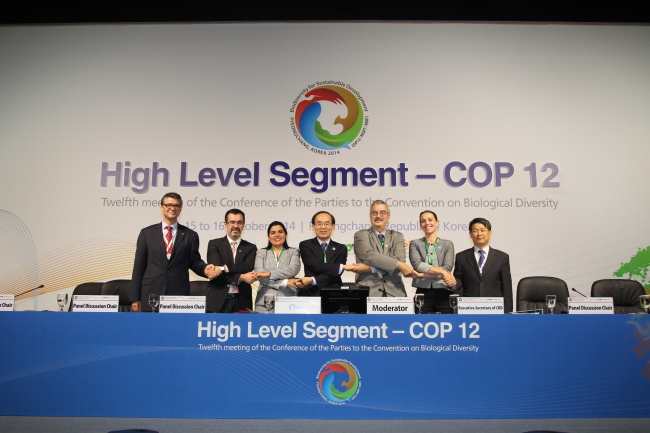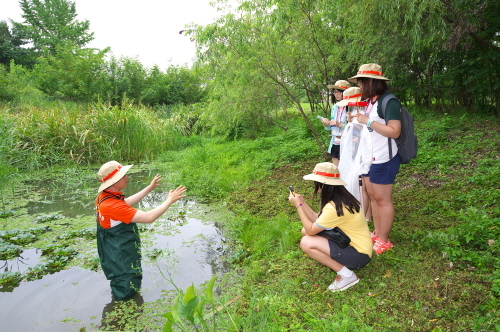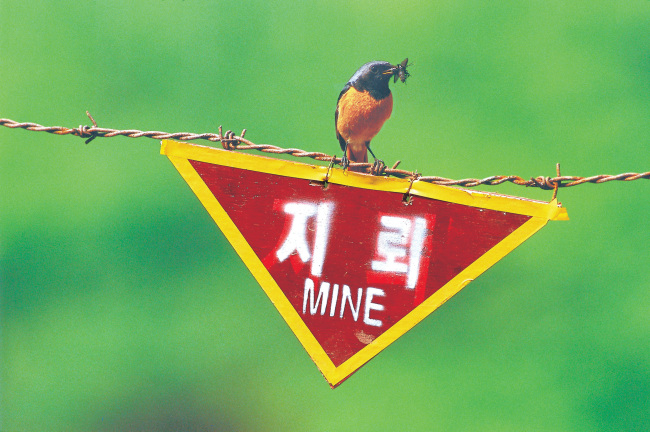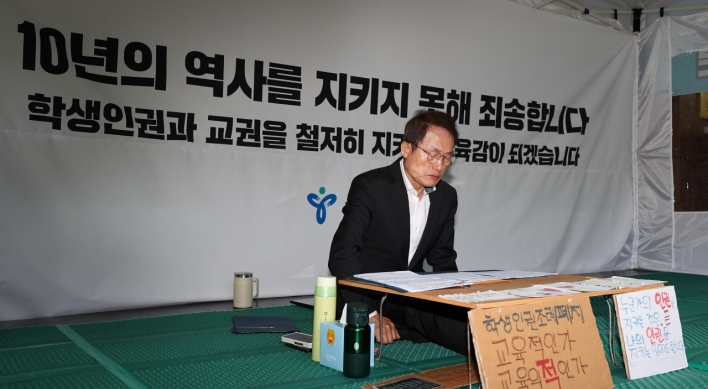PYEONGCHANG, Gangwon Province ― The 12th meeting of members of the Convention of Biological Diversity closed Friday with the global community showing its commitment to increasing funding significantly to achieve conservation targets.
The members adopted the Gangwon Declaration and Pyeongchang Roadmap after their three-week discussions in the eco-friendly district in Gangwon Province, which began on Sept. 29. About 25,000 officials and observers from 164 countries participated in the conference.
Biodiversity refers to genetic, species and ecosystem variation, and the United Nations-led convention aims to preserve this diversity.
The members adopted the Gangwon Declaration and Pyeongchang Roadmap after their three-week discussions in the eco-friendly district in Gangwon Province, which began on Sept. 29. About 25,000 officials and observers from 164 countries participated in the conference.
Biodiversity refers to genetic, species and ecosystem variation, and the United Nations-led convention aims to preserve this diversity.

Under the Gangwon Declaration adopted, members reached a consensus that the global community would call on the U.N. to include biodiversity preservation as one of the development goals for the coming years.
Members have responded by committing themselves to redoubling their efforts in support of the vision of the strategic plan for biodiversity, including the financial resources needed to make this a reality, Braulio Ferreira de Souza Dias, U.N. assistant secretary-general and executive secretary of CBD, said in his closing statement.
“Their commitments show the world that biodiversity is a solution to the challenges of sustainable development and will be a central part of any discussions for the post-2015 development agenda and its sustainable development goals,” he said.
South Korea’s Environment Minister Yoon Seong-kyu stressed that the Gangwon Declaration reflected a strong message from members that the importance of biodiversity should be highlighted in the post-2015 development agenda.
“We are planning to report and submit it to the U.N. General Assembly,” said Yoon.
The minister pledged that “Korea will fully assume its responsibility to bridge the gap between developed and developing countries by tapping into the creative economy approach in the field of biodiversity.”


Korea, as the chair, proposed four new initiatives during the conference ― the biobridge initiative in support of technical & scientific cooperation; the forest ecosystem restoration initiative; the peace & biodiversity initiative in support of transboundary cooperation; and further support for the sustainable ocean initiative.
The four initiatives also take up a significant part of the Pyeongchang Roadmap.
The biobridge initiative, in particular, aims to effectively link the technological and scientific capacity as well as financial resources in advanced countries to the need for science and technology in developing countries.
Under the roadmap, responding to the call initiated at the 10th meeting in Nagoya, Japan, governments worldwide reaffirmed their agreement made at the 11th meeting in Hyderabad, India, to double the total biodiversity-related international financial resource flows to developing countries.
Governments of the member countries also agreed to increase domestic financing for biodiversity and identified a set of actions to allow for the increased mobilization of financial resources from all sources.
The decisions incorporate actions that demonstrate a recommitment to implementing the Strategic Plan for Biodiversity 2011-2020 and achieve its Aichi Biodiversity Targets, agreed by the international community in the Japanese prefecture in 2010.
According to the Montreal-based CBD secretariat, the roadmap is aimed at the enhanced implementation of the strategic plan and achievement of the Aichi Biodiversity Targets.
The CBD’s three main objectives are the conservation of biological diversity involving genetic, species and ecosystem variation; the sustainable use of the components of biological diversity; and the fair and equitable sharing of benefits arising out of the utilization of genetic resources.
As an outcome, conference members reached a decision on health and biodiversity that will see increased collaboration between the CBD and the World Health Organization.
“Decisions related to disaster risk reduction and ecosystem restoration will not only contribute to the sustainable use and conservation of biodiversity but also goals related to sustainable development,” said the secretariat.
The Pyeongchang meeting also adopted milestones for the full implementation of Aichi Biodiversity Target on incentives. The decision includes a timetable and concrete activities for the elimination, phasing out or reform of incentive policies that are harmful to biodiversity, as well as the promotion of positive incentive policies.
The meeting also adopted decisions that related to the first meeting of the Conference of the Parties serving as the meeting of the Parties to the Nagoya Protocol on Access to Genetic Resources and the Fair and Equitable Sharing from the Utilization of Genetic Resources.
Under the Nagoya Protocol, which took effect Oct. 12, access to genetic resources for their utilization should be subject to the prior informed consent of the a member country providing such resources.
Kim Hyo-jung, director of the Korean secretariat of the CBD, commented on the biodiversity and ecosystems in border areas. “Benchmarking the cases in Germany, Finland, Austria, Peru and Ecuador, we (South Korea) have proposed a dialogue for building peace and preserving biological diversity.”
She said the discussions on the border areas, held as a sideline event of the conference, are estimated to have become an opportunity in gaining the international community’s support for South Korea’s move to foster a world eco-peace park in the demilitarized zone between the two Koreas.
In the Gangwon Declaration, the general term “border” was officially mentioned though the Korean Peninsula’s specific “DMZ” was not included.
The nation’s main speakers at the sessions included Prime Minister Chung Hong-won, Gangwon Province Governor Choi Moon-soon and Environment Minister Yoon.
As another noteworthy sideline event, Gangwon Province hosted a biodiversity summit of municipal governments from Oct. 13-14.
The summit was designed to identify the role of local governments in accomplishing global biodiversity goals. Among the participants were heads of local governments from 81 cities worldwide and related international organizations.
According to a media release from the CBD secretariat, the Pyeongchang meeting was conducted under a new paper management system, which resulted in a 60 percent reduction in the use of paper compared to previous gatherings.
Meanwhile, Mexico has been picked as chair for the coming 13th meeting in 2016 while Turkey reportedly expressed its desire to host the 14th biennial meeting.
Signed at the Earth Summit in Rio de Janeiro in 1992, and entering into force in December 1993, the CBD is an international treaty for the conservation of biodiversity, the sustainable use of the components of biodiversity and the equitable sharing of the benefits derived from the use of genetic resources.
With 194 parties up to now, the U.N.-based convention has near universal participation among countries.
The convention seeks to address all threats to biodiversity and ecosystem services, including threats from climate change, through scientific assessments; the development of tools, incentives and processes; the transfer of technologies and good practices as well as active involvement of relevant stakeholders.
Among the stakeholders are local communities, the youth, NGOs, women and the business community.
The Cartagena Protocol on Biosafety and Nagoya Protocol on Access and Benefit Sharing are supplementary agreements to the convention.
The Cartagena Protocol, adopted in 2000 in Colombia, seeks to protect biological diversity from the potential risks posed by living modified organisms resulting from modern biotechnology. To date, 167 countries plus the European Union have ratified the Cartagena Protocol.
The Nagoya Protocol aims at sharing the benefits arising from the utilization of genetic resources in a fair and equitable way, including by appropriate access to genetic resources and by appropriate transfer of relevant technologies. It has been ratified by 53 countries plus the EU.
By Kim Yon-se (kys@heraldcorp.com)





![[KH Explains] No more 'Michael' at Kakao Games](http://res.heraldm.com/phpwas/restmb_idxmake.php?idx=644&simg=/content/image/2024/04/28/20240428050183_0.jpg&u=20240428180321)












![[Herald Interview] Mistakes turn into blessings in street performance, director says](http://res.heraldm.com/phpwas/restmb_idxmake.php?idx=652&simg=/content/image/2024/04/28/20240428050150_0.jpg&u=20240428174656)
